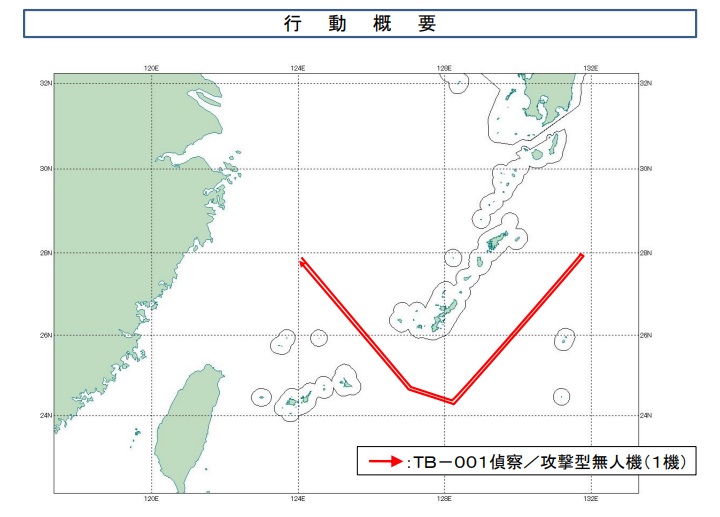On June 4, the Japanese Ministry of Defense confirmed for the first time that a Chinese military reconnaissance and attack drone had flown over waters off the southwestern Japanese island of Amami Oshima in Kagoshima Prefecture.
A TB-001 medium-altitude long-endurance (MALE) unmanned aerial vehicle (UAV), used by the People’s Liberation Army, was spotted flying from the East China Sea between the morning and afternoon of June 4. The UAV passed between the main island of Okinawa and Miyakojima and then proceeded into the Pacific Ocean, according to a statement that day from the Defense Ministry. It then flew north over the Pacific Ocean to the coast of Amami Oshima, then turned around and returned on the same route, heading toward the Chinese mainland, the statement said.
The Japan Air Self-Defense Force (JASDF) scrambled fighter jets to deal with the drone, which threatened to intrude into Japan’s territorial airspace. In the end, the UAV didn’t violate Japanese airspace.
On May 27, the JASDF also spotted another type of Chinese reconnaissance and attack drone, the Wing Loong-10, for the first time, flying over the East China Sea. This also forced Japanese fighter jets to scramble to intercept the drone, seen operating first time ever north of Okinawa.
The Defense Ministry is carefully monitoring moves by the Chinese military as it is seen to be intensifying activities around the Japanese archipelago.
The ministry has not revealed the results of its analysis into the purpose of the Chinese UAVs’ recent flights.
However, the 2023 Defense White Paper published by the Japanese Defense Ministry in July 2023 touched on the subject:
China is rapidly developing a variety of domestic unmanned aerial vehicles (UAVs), including high-altitude, long-endurance (HALE) UAVs for reconnaissance and other purposes as well as those capable of carrying weapons such as missiles. Some of these are deployed and actively exported. In fact, it is suggested that the Chinese Air Force has created a UAV unit for attack missions and frequently used UAVs for reconnaissance and other purposes in waters and airspace surrounding China.
With a more assertive China in mind, since the 2010s the Japan Ground Self-Defense Force has been rapidly deploying missile units in the nation’s southwestern Nansei island chain, which spans about 1,200 kilometers from Kagoshima to Okinawa, stretching southwest toward Taiwan. The chain includes the disputed Senkaku/Diaoyu Islands, which are controlled by Japan but also claimed by China and Taiwan.
There are reports that missile storage facilities are being constructed in tunnels in the mountains on Amami Oshima Island, and on flat land on Miyakojima Island in Okinawa. Chinese drones may be spying on these facilities.
China in recent years has apparently aimed to assert its military presence and stepped up challenges to its neighbors’ maritime claims in the East and South China seas and elsewhere. Its coast guard has been making repeated incursions into waters around the Japan-administered Senkaku Islands.
Japanese public broadcaster NHK on June 2 reported that the China Coast Guard 2901, one of the China Coast Guard’s largest vessels, has been increasingly sailing near the median line between Japan and China in the East China Sea while transmitting its location data.
The vessel is based at a port in Zhejiang Province with a length of 165 meters and a displacement of about 10,000 tons. It carries a 76-millimeter cannon.
- SEO Powered Content & PR Distribution. Get Amplified Today.
- PlatoData.Network Vertical Generative Ai. Empower Yourself. Access Here.
- PlatoAiStream. Web3 Intelligence. Knowledge Amplified. Access Here.
- PlatoESG. Carbon, CleanTech, Energy, Environment, Solar, Waste Management. Access Here.
- PlatoHealth. Biotech and Clinical Trials Intelligence. Access Here.
- Source: https://thediplomat.com/2024/06/japan-confirms-chinese-military-drone-flew-off-the-japanese-coast/




